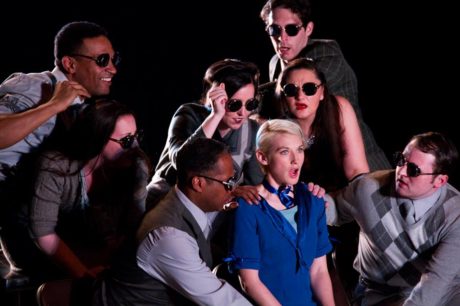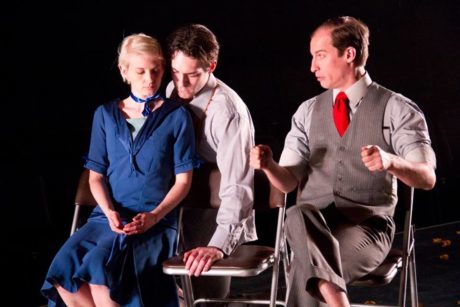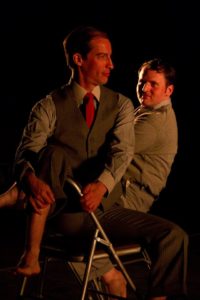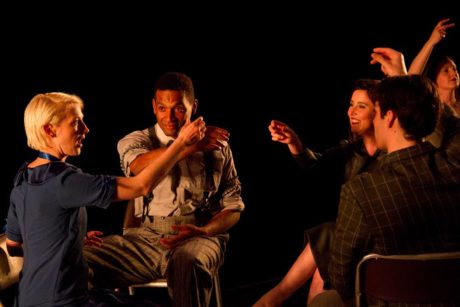Machinal by Sophie Treadwell, considered one of the most important Expressionist plays in the United States, premiered on Broadway in 1928. Inspired by the life of Ruth Snyder, who was convicted of and executed for murder, this dark play captivated audiences and earned accolades from its inception, including Burn Mantle’s The Best Plays of 1928-1929. In response to the 1954 TV production, the New York Times wrote, “Sophie Treadwell’s expressionistic and bitter poem for the theatre must rank among the video season’s finest accomplishments.”

Brenna Geffers, an innovative director based out of Philadelphia, has directed a wide-range of plays from classical works to contemporary productions, in addition to creating her own theatrical pieces. She has served as Associate Artistic Director for Theatre Exile, a Literary Director for EgoPo Classic Theater, and an Artistic Associate for Flashpoint Theatre. Recently, as part of EgoPo’s all-women’s drama series, Geffers directed a shockingly beautiful production of Treadwell’s Machinal.
“When these kinds of artists get into a room together, it can be a wild ride.”
Henrik: You often use a collaborative approach with the cast. Could you give a few examples where cast members presented ideas that you were able to integrate into your production?
Brenna: The cast for this show is incredible; their imaginations and instincts are gold mines for any director. As EgoPo has three weeks to put up a play, this is invaluable. We all have to work hard and work fast. The cast and I met with Peter Andrew Danzig’s Philadelphia Theatrical Trainer for a few hours of workshopping before the rehearsal process started. Through different exercises and improvisations, we created many gestures and movement patterns, some of which were used in the production. For example, Mary [Tuomanen]’s first moment was derived from a series she made at the workshop that resonated with me and which I recorded.

Steven Wright and I talked a lot about the movement language of the piece before we went into rehearsals and those conversations were essential to me. I had engaged Steven to work as a sort of ensemble captain with me on this piece because of the unique way he embodies his modern dance training into his own unique style. He created one of my favorite moments of the play where the four men accuse the Young Woman of being crazy and then execute this sweeping-side-step gesture. I love it and he taught the entire ensemble this sequence during the workshop day. His physical work as the priest in the final scene astounds me still.
Lee Minora, one of the funniest ladies in town, made so many strong proposals for the First Scene and really was the engine of that work. She set the bar early and high. Carlo Campbell made one of my favorite gestural proposals for a wicked moment in the Speakeasy Scene. Carlo’s natural athleticism also makes him a “Breath Captain” in the ensemble, as well as “Defense” to keep group movement strong and safe.
The first time Colleen Corcoran dropped to her knees with “morning sickness” in Scene 5, her fellow actors almost stopped the run. Colleen is one of my favorite collaborators in town; her choices come straight from the heart and have the added sugar-coating of her unflappable charisma.
Shamus McCarty is newer to me for this kind of work, so when his “ADA Jonathan Paramour” set the courtroom on fire with re-cap montage of a million gestures, I could barely take it.
Chris Anthony is truly blessed with natural scene chops as well as a physical grace and control that would make a dancer nod her head in approval. When I showed Chris my inspiration for the movement of Male Objectification, he nodded silently, thought about it, and came back with guns a-blazing.
When these kinds of artists get into a room together, it can be a wild ride. The hope is that we work together to make the rules of the language that then anyone can pull from to make a moment.
Mary Tuomanen and her guardian angel
Everyone I talked to after the two performances that I saw, went into raptures about Mary Tuomanen. Even my two guests from Germany who had never heard of her, wouldn’t stop talking about the play and Mary’s presence and performance in particular. What was it like working with her?
This is the first time I had the pleasure of working with Mary. I had seen her work many times and was always struck by it. Her work in the Arden’s Three Sisters was impeccable. Even if I see her in a script that is not my cup of tea, her dazzlingly specific work always makes me glad I came to the theater. Not only is she a brilliant performer, but I also admire her as an activist. Her work with Applied Mechanics (one of my favorite companies), Bearded Ladies, and her own solo work uses art to challenge society in a way that I find hard to even quantify. Her activism is present, but is delivered by the smart yet oh-so-delicious aesthetic, if that makes sense. I find it really inspiring as a human being. So I was really happy when she came on board for this show specifically.
Mary Tuomanen is smart, intuitive and a perfectionist. She is careful and knowledgeable about the work, but then is able to live freely and boldly in the moment in front of any audience. Her work is always her own. It is fully unique. It is a gift.
Your opera singer served as an important presence, standing on a platform, her voice flying through the theater, hovering over the cast.
One of the unique aspects of our production was the embodiment of the Guardian Angel, as played by Kirsten Kunkle. Her voice embodied the human longing within the Young Woman. Within all of the metal and harshness of the world, there was the voice calling out to the Young Woman, daring her to keep going. Kirsten is like a Siren from a dark sea, seducing the Young Woman to jump off the ship.

Kirsten and I have worked together as part of the Philadelphia Opera Collective for a few years now. Most recently, she was in my new opera Jump the Moon for the Fringe. Kirsten is an amazing artist. Obviously she is a gifted soprano with a powerful and beautiful voice. But she is also an amazing performer. She knows how to use her whole body to tell a story, not just her voice. I personally find her to be hypnotizing on stage and she is really willing to make bold choices. I always look for excuses to have her on the team. She and I have two projects this summer, including another new opera.
Wilma training spreading through the theater community
Ross Beschler and Ed Swidey are members of the Hothouse group at the Wilma Theater, with its intensive sessions by Blanka Zizka, who is committed to a wide range of voices, viewpoints, and styles, providing rigorous vocal and physical training. How did the Hothouse work influence your production?

I am a huge admirer of the Wilma, particularly of their dedication to the craft of theater via new viewpoints and acting methods. Blanka’s invention of the Hothouse ensemble is inspiring, but the master classes and the training she has been able to bring into the city go beyond the members of Hothouse. Many actors and directors have participated in Wilma master classes, workshops, and training sessions. I know my work has benefited from it, personally, but also through the actors I work with who have gone through some Wilma training. I am sure many directors also have had cast members who trained there. It makes the work all around the city stronger, deeper, and better.
For example last season, Ross Beschler and Ed Swidey led a workshop with the cast of the Hairy Ape [by Eugene O’Neill] to show some of the breath work they had learned in Athens, Greece via connections through the Wilma. Matteo [Scammel] had already been exposed to such training through the Wilma and was able to keep leading the cast though warmups for the entire process. In turn, many ensemble members from Hairy Ape returned for Machinal, bringing in that shared experience and passing it on to new cast members. They use it on their own to help each other in their ensemble work. Of course, this does not compare to the dedicated work Hothouse is doing, but I cannot thank the Wilma enough for bringing this training into Philly and allowing it [to] spread through the community.
SoLow Fest-ing and Fringe Fest-ing with an immersive opera
What are your creative plans for this year and next year?
Next up is the SoLow Fest, which I am rehearsing for now. I am working with KO DelMarcelle on one piece, as well as Colleen Hughs and Rachel Gluck on another. I have a few projects to take me through the summer in Cape Cod, Scranton Shax, and in the Pittsburgh area. I will be back in Philly in August to start rehearsals for the Fringe. At this festival, I am making an immersive opera at the Powel House. There are a bunch of different timelines for audiences to follow throughout the historic mansion, so I am very excited to craft that. It’s called Shadow House, and I hope you will see it.

I would be delighted, even though I can’t imagine how one can go beyond your Treadwellian Machinal—one of the best productions I have seen in years.
Running Time: Two hours, with an intermission.
Machinal played through May 8, 2016 at EgoPo Classic Theater performing at The Latvian Society – 531 North 7th Street, in Philadelphia, PA.
LINKS:
Lover, Wife, and Murderess—EgoPo’s Stunning ‘Machinal’: Interview with Director Brenna Geffers: Part 1.
‘Machinal’ at Ego Po Classic Theater in Philadelphia reviewed on DCMetroTheaterArts by Neal Newman.
Brenna Geffer’s website.




